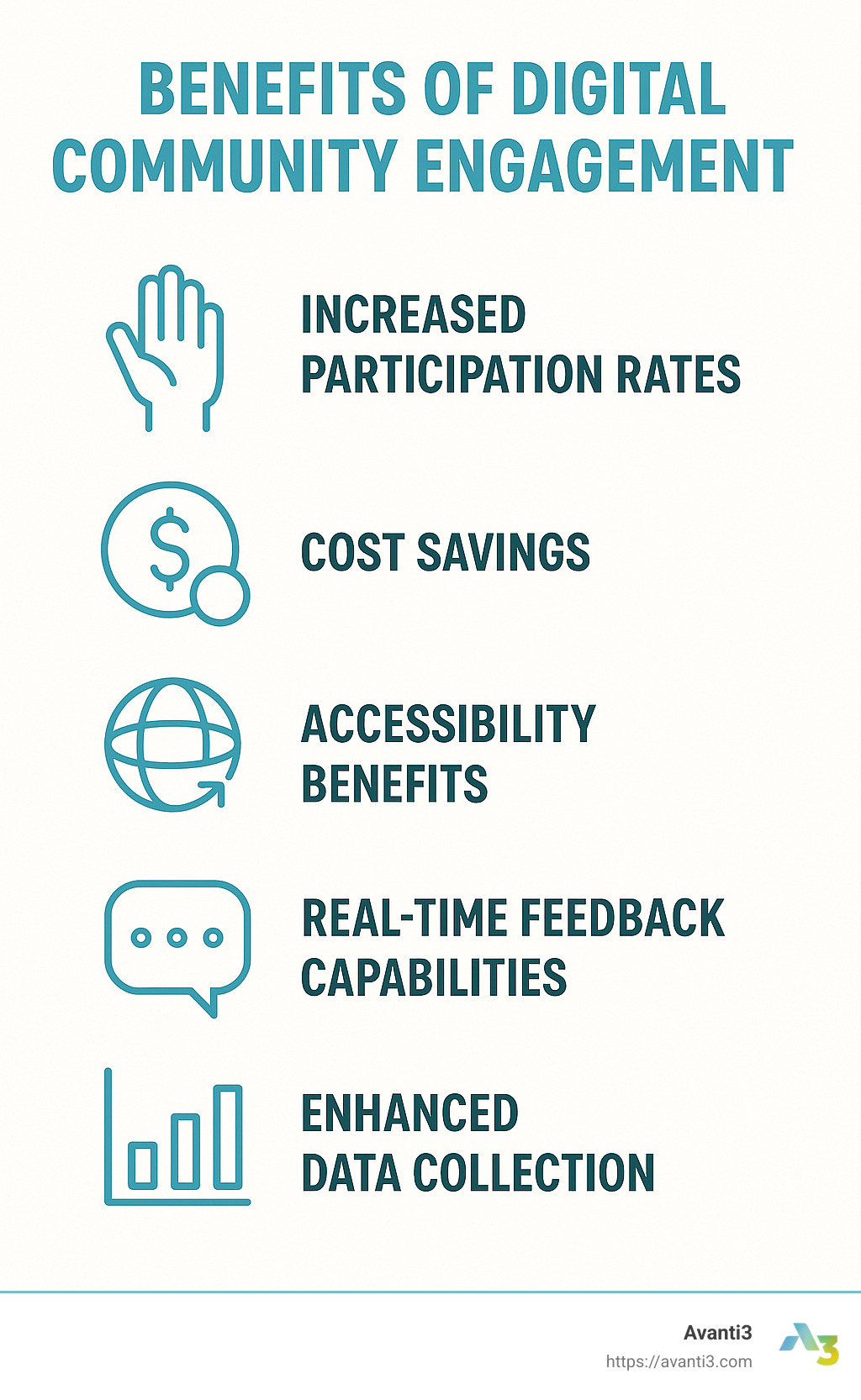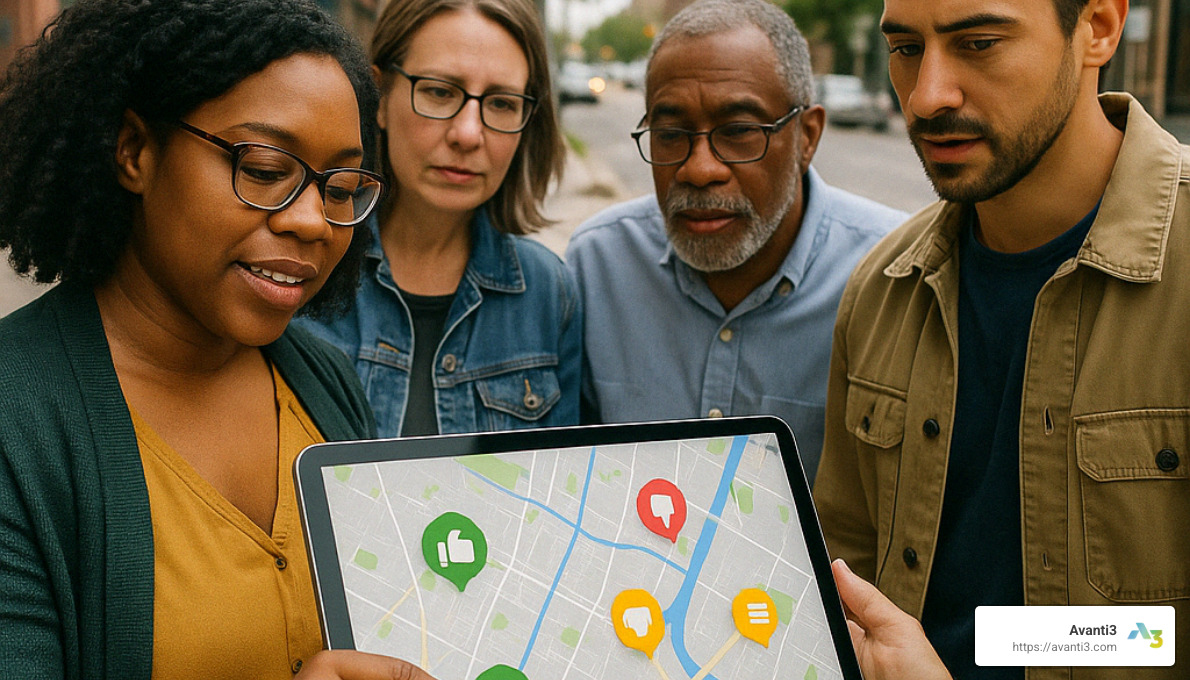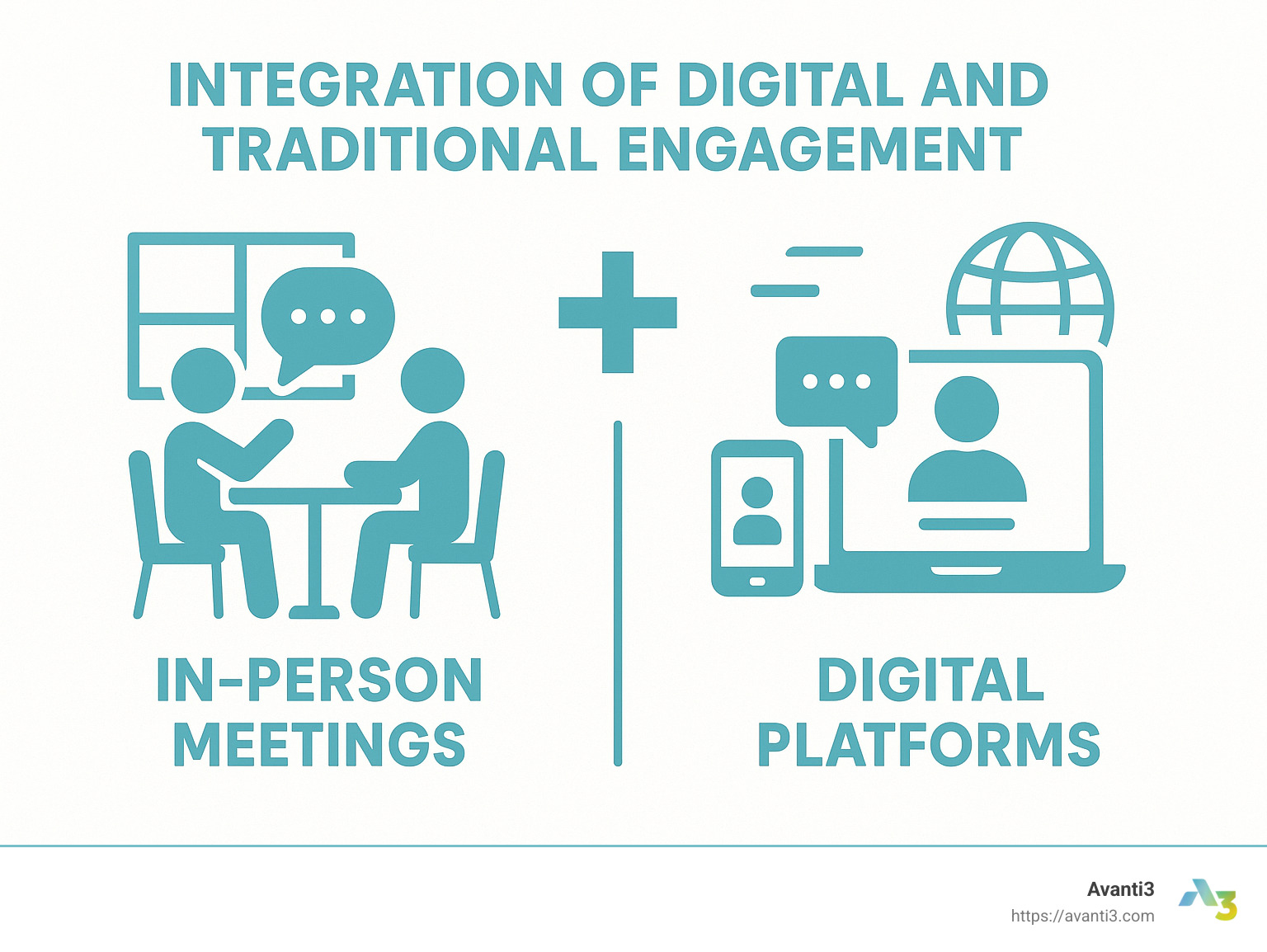Digital Community Engagement: Top 5 Powerful Benefits 2025
Empowering Communities Through Digital Connection
Digital community engagement refers to the process of involving and connecting with community members through online platforms and digital tools. It enables organizations to interact with their audiences, gather feedback, and build relationships in virtual spaces.
What is digital community engagement?
- A way to connect with community members online
- Uses digital tools like forums, surveys, social media, and interactive maps
- Enables two-way communication between organizations and communities
- Helps gather feedback, share information, and build relationships
From local governments consulting on urban planning to brands building loyal customer communities, digital engagement has transformed how we connect with one another. As one expert in the field noted, “From the beginning of time, community engagement has been the core of humanity.” Today, this fundamental human need has evolved into the digital field, opening new possibilities for connection and collaboration.
Digital community engagement removes traditional barriers of time and location, allowing people to participate from anywhere, at any time. This accessibility has led to remarkable results, with some organizations reporting a 400% increase in community participation compared to traditional methods, along with cost savings of 30-90% per participant.
I’m Samir ElKamouny, founder of Avanti3, and I’ve dedicated my career to helping organizations build meaningful digital community engagement strategies that transform online interactions into powerful connections and actionable insights. My experience has shown that when digital engagement is done right, it doesn’t just collect opinions—it builds trust, fosters inclusivity, and empowers communities to shape their own futures.

Understanding Digital Community Engagement
Picture this: a neighborhood meeting about a new park development, but instead of 20 people in a community center on a Tuesday evening, hundreds of diverse voices contribute ideas over several weeks from the comfort of their homes. That’s the power of digital community engagement in action.
At its heart, digital community engagement is about creating meaningful connections between organizations and the people they serve—just through digital channels instead of traditional face-to-face methods. It’s the art of building relationships, gathering insights, and fostering dialogue using technology as the bridge rather than the barrier.
“From the beginning of time, community engagement has been the core of humanity. It is what first connected humans together and continues to shape our digital interactions today.”
This quote reminds us that our desire to connect isn’t new—it’s hardwired into who we are as humans. What’s changed is how we express this fundamental need. Today’s digital tools have simply expanded our ability to fulfill this ancient desire for connection and belonging.
The role of digital community engagement in our society goes far beyond just having a social media presence. It’s changing how we participate in democracy, with local governments using online platforms to gather input on everything from budget priorities to park designs. It’s building bridges across geographic and social divides, allowing people with shared interests to find and support each other. It’s democratizing knowledge sharing, giving voice to expertise that might otherwise go unheard.
When done well, digital community engagement builds trust through transparency. It solves complex problems by tapping into collective wisdom. It creates spaces where genuine relationships can flourish, even without physical proximity.
The COVID-19 pandemic dramatically accelerated this digital shift, turning what was once considered a “nice-to-have” alternative into an essential approach. Organizations finded that virtual town halls often attracted three times the participation of physical meetings. Online surveys reached demographics that rarely attended community events. Digital forums captured thoughtful input from people who might never speak up in a crowded room.
The beauty of digital community engagement is its ability to meet people where they are—whether that’s on a smartphone during a lunch break, a tablet while putting kids to bed, or a computer late at night when inspiration strikes. This flexibility has proven particularly valuable for engaging parents of young children, people with disabilities, shift workers, and others whose schedules or circumstances make traditional participation difficult.
As we continue navigating an increasingly digital world, understanding how to effectively engage communities online isn’t just a nice skill to have—it’s becoming essential for any organization that values the perspectives of the people it serves. The organizations that thrive will be those that recognize digital community engagement not as a technological challenge but as a human opportunity.
The Benefits and Advantages of Digital Community Engagement
Digital Community Engagement vs Traditional Methods
When we talk about connecting with communities, there’s a world of difference between digital and traditional approaches. I’ve seen how digital community engagement can transform participation rates while dramatically reducing costs.
Think about your typical town hall meeting. While there’s something genuinely valuable about face-to-face interaction, these traditional gatherings come with serious limitations. They’re often attended by the same familiar faces, leaving many voices unheard.
| Aspect | Traditional Methods | Digital Methods |
|---|---|---|
| Accessibility | Limited by location, time, and physical ability | Accessible from anywhere with internet access, at any time |
| Reach | Often limited to those who can attend in person | Potential to reach a wider, more diverse audience |
| Cost | Approximately $200 per participant | As low as $5 per participant (30-90% savings) |
| Feedback Collection | Manual, time-consuming process | Automated, real-time data collection |
| Representation | Often dominated by the “usual suspects” | Can reach underrepresented groups more effectively |
| Duration | Typically one-time events | Can enable ongoing, continuous engagement |
| Format | Usually verbal, in-person communication | Multiple formats (text, images, video, maps, etc.) |
| Analysis | Often subjective, labor-intensive | Data-driven, can use AI for pattern recognition |
I often hear skeptics ask, “Don’t the traditional methods work just fine?” The honest answer is that while they have their place, they’re increasingly insufficient on their own. A standard public meeting can cost around $10,000 or more, averaging about $200 per participant. Compare that to digital methods, which can bring that cost down to roughly $5 per person—saving organizations between 30-90% of their engagement budget.
But it’s not just about money. It’s about reaching people where they are, on their terms, and in ways that fit their lives.
Key Benefits of Digital Community Engagement

Let me share why digital community engagement has become essential in our connected world.
Accessibility opens doors for everyone. Digital platforms extend participation to anyone with internet access, regardless of their location or schedule. This is particularly meaningful for working parents, students, and people with mobility challenges who might otherwise miss out on having their voices heard.
The cost savings are substantial. As I mentioned earlier, digital engagement dramatically reduces the cost per participant. This means organizations can engage with more people using the same budget—a win-win for everyone involved.
Digital tools build more inclusive communities. By removing barriers like transportation issues, childcare needs, and rigid work schedules, we can finally reach those underrepresented groups whose perspectives are so often missing from community conversations. Features like translation tools and screen readers further improve accessibility.
Real-time feedback changes the game. Instead of waiting weeks for survey results to be compiled, digital platforms enable immediate interaction through live polls and comment sections. This quick turnaround allows organizations to adapt on the fly.
Transparency builds trust. Online platforms create a central hub where anyone can access project information, updates, and decision-making processes. This openness fosters trust between organizations and community members.
Data-driven decisions lead to better outcomes. Digital engagement generates valuable insights that can be analyzed to identify patterns and priorities. This evidence strengthens the credibility of decisions and helps ensure they reflect genuine community needs.
Ongoing dialogue deepens relationships. Unlike one-time events, digital platforms enable continuous engagement throughout a project’s lifecycle. This sustained conversation builds stronger connections and more nuanced understanding.
Multiple formats make complex information digestible. Videos, images, interactive maps, and other media can make technical information more accessible and engaging for everyone.
The results speak for themselves—organizations implementing digital approaches have seen up to a 400% increase in community participation. That’s not just a statistic; it represents hundreds or thousands of additional voices contributing to important decisions.
Case Studies of Successful Digital Community Engagement

Let’s look at some real-world examples of digital community engagement in action—because seeing is believing.
In Vantaa, Finland, a digital mapping tool called Maptionnaire revolutionized how the city approached urban planning. Over just two years, they managed more than 200 participatory projects across ten divisions and engaged over 50,000 residents. What made this approach so effective was how it connected community feedback directly to specific locations on interactive maps.
As one research publication noted, “Associating local knowledge with a location makes it more usable.” The spatial approach made feedback immediately actionable for planners. In Finland, 69% of participation projects now include map-based engagement questions—a testament to how effective this approach has become.
The results? A 400% increase in participation compared to traditional methods, with insights gathered from a much more representative sample of residents.
A local police department offers another compelling example. They implemented a digital platform to collect citizen feedback without increasing their already stretched staff workload. The platform enabled real-time communication during emergencies, provided easy access to safety information, and created two-way feedback mechanisms with community groups, schools, and businesses.
As their project leader observed, “The rise of technology has created more opportunity—and greater expectations—for police community engagement.” By embracing digital tools, the department built stronger community relationships and addressed concerns more effectively.
The Greater Cambridge planning team took a digital-first approach to their Local Plan consultation, combining social media campaigns with digital surveys and interactive mapping. Their first digital survey attracted 1,200 unique users and generated over 7,000 comments. Their website received more than 4,000 unique visitors, with 65% of traffic coming through social media channels that reached 281,600 people.
What’s particularly instructive about the Cambridge example is how they blended digital and traditional methods. While digital tools formed the backbone of their strategy, they also organized pop-up events in busy public spaces to reach those who might not engage online.
These real-world examples show that digital community engagement delivers measurable results. By embracing these tools and strategies, organizations can reach more people, gather better data, and make more informed decisions that truly reflect their communities’ needs and priorities.
Implementing Digital Community Engagement Strategies
Tools and Platforms for Digital Community Engagement
When it comes to bringing digital community engagement to life, having the right tools makes all the difference. Think of these platforms as the digital town squares where communities gather, share ideas, and build relationships in the virtual world.
Social media platforms like Facebook, Twitter, and Instagram offer immediate ways to connect with community members, especially younger folks who practically live online. They’re perfect for quick updates and casual conversations. But they’re just the beginning of what’s possible.
Specialized community engagement software – like what we offer at Avanti3 – takes things further by combining surveys, forums, idea boards, and interactive maps in one place. It’s like having an entire community center in digital form, with the added benefit of built-in analytics to help you understand what’s working.
Map-based engagement tools have become game-changers, particularly for urban planning projects. There’s something powerful about seeing feedback tied to specific locations – suddenly, abstract comments become concrete suggestions when pinned to a map. As one Finnish planning team finded, these spatial approaches make community input far more actionable.
Mobile apps, virtual town halls, and text messaging systems round out the digital toolkit, each serving unique purposes in reaching different segments of your community. The beauty of these tools isn’t just their convenience – it’s their ability to reach people who might never attend a traditional community meeting.
At Avanti3, we’ve taken digital community engagement to the next level by incorporating Web3 technologies. Blockchain ensures transparency in participation, while NFTs can reward active community members in unique ways. AI helps make sense of thousands of comments without losing the human touch, and AR/VR creates immersive experiences that help people visualize potential changes to their communities.
The secret to success isn’t just picking the flashiest tools – it’s choosing platforms that match your community’s needs, technical comfort levels, and engagement goals. A retirement community might benefit from different approaches than a college campus, for instance. The best engagement strategies recognize these differences and adapt accordingly.
Want to explore digital engagement platforms in more depth? We’ve compiled extensive information about Digital Engagement Platforms to help you find the perfect fit for your community.
Best Practices for Digital Community Engagement
Creating meaningful digital community engagement is as much about approach as it is about technology. After years of helping organizations build vibrant online communities, we’ve identified practices that consistently lead to success.
Start early. There’s nothing more frustrating for community members than being asked for input after all the important decisions have already been made. Digital tools make it easier than ever to involve people from day one, shaping initiatives together rather than simply seeking approval for finished plans.
Make participation ridiculously easy. Every extra click, form field, or complicated step will cause some people to drop out of the process. The most successful digital engagement efforts keep barriers low – simple interfaces, minimal registration requirements, and intuitive design all contribute to higher participation rates.
“Associating local knowledge with a location makes it more usable.” This insight from Finnish planners highlights why map-based approaches work so well – they connect feedback to specific places, making abstract suggestions concrete and actionable.
Accessibility isn’t optional – it’s essential. Your digital engagement tools should work for everyone, including people with disabilities, those with limited technology access, and community members who speak different languages. Universal design principles ensure no one gets left out of the conversation.
Clear, conversational language beats jargon every time. Even complex topics can be explained in straightforward terms that invite participation rather than intimidate. Visual elements – photos, videos, infographics – can make information more digestible and engaging for everyone.
Effective moderation creates safe spaces for honest dialogue. Clear community guidelines, consistently applied, help prevent conversations from being dominated by the loudest or most aggressive voices. Good moderation isn’t about censorship – it’s about ensuring everyone feels welcome to contribute.
Transparency builds trust. When community members provide input, they deserve to know how their feedback influences decisions. Closing the loop by sharing results and explaining how input shaped outcomes encourages continued participation and demonstrates respect for community voices.
One engagement director put it perfectly: “It was really crucial that the engagement team had the ability to create and shape and respond to online interactions without needing to be dependent on our IT department for support.” Empowering your team with the right skills and authority makes digital engagement more responsive and authentic.
For a deeper dive into community engagement principles, the Principles of Community Engagement report offers valuable insights that complement these digital-specific practices.
Leveraging Technology for Effective Digital Community Engagement
Technology isn’t just changing how we engage communities – it’s expanding what’s possible when we do. The right tech approaches can transform digital community engagement from a one-way information push into a dynamic, collaborative experience that generates genuine insights.
Map-based tools have revolutionized community input, especially for projects with a physical dimension. Instead of vague comments, participants can place pins on exact locations, draw routes showing transportation patterns, or highlight areas of special significance. This spatial approach transforms abstract feedback into actionable insights that planners and decision-makers can immediately visualize and incorporate.
The real-time nature of digital platforms creates new possibilities for responsive engagement. Imagine hosting a virtual town hall where you can poll participants instantly, seeing community sentiment shift as different ideas are discussed. Or picture a comment section where staff can immediately clarify misunderstandings before they spread. This immediate feedback loop makes engagement more dynamic and meaningful for everyone involved.
AI and analytics are perhaps the most exciting frontier in digital community engagement. When thousands of community members provide input, making sense of all that data becomes challenging. Natural language processing can identify common themes in open-ended responses, while sentiment analysis gauges emotional reactions to proposals. These technologies don’t replace human judgment – they improve it by surfacing patterns that might otherwise go unnoticed.
Personalization makes engagement more relevant for each participant. Digital tools can learn what topics interest specific community members, sending targeted notifications about projects in their neighborhood or issues they’ve expressed interest in. This custom approach respects people’s time and attention, increasing both participation rates and the quality of feedback received.
The most powerful digital community engagement strategies integrate multiple technologies into seamless experiences. Rather than forcing community members to steer disconnected tools, integrated platforms provide consistent, intuitive experiences across different types of engagement. This reduces friction for participants and provides organizations with a more comprehensive view of community sentiment.
What makes these technologies truly transformative isn’t their technical sophistication – it’s how they amplify human connection. At their best, digital engagement tools don’t replace face-to-face interaction; they extend and improve it, creating more opportunities for meaningful dialogue and collaborative problem-solving.
The future of digital community engagement lies in thoughtfully applying these technologies to create experiences that are more accessible, more inclusive, and ultimately more impactful for the communities we serve.
Overcoming Challenges and Integrating Traditional Methods
Challenges and Solutions in Digital Community Engagement
Let’s face it – while digital community engagement offers amazing benefits, it’s not without its problems. I’ve seen organizations struggle with these challenges, but I’ve also witnessed some brilliant solutions that turned potential roadblocks into stepping stones.

The digital divide remains one of our biggest challenges. Not everyone has equal access to technology or the internet, and this gap often falls along socioeconomic, age, and geographic lines. I remember working with a small town where nearly 40% of seniors had limited or no internet access – clearly, a purely digital approach would have left many voices unheard.
Smart organizations are tackling this by providing access at community hubs like libraries and community centers. Mobile-friendly platforms have been game-changers too, since smartphones have higher penetration rates than computers in many communities. Some of the most successful initiatives I’ve seen offer offline options alongside digital ones and provide digital literacy training to build skills and confidence.
As one engagement specialist beautifully put it:
“None of us is an expert in consultation in a pandemic. We need to ask our communities how they would like to participate and what works for them.”
This mindset – asking rather than assuming – makes all the difference in bridging the digital divide.
Privacy and data security concerns can also make people hesitant to participate. Who wants to share their thoughts if they’re not sure where that information will end up? Successful digital community engagement requires building trust through robust security measures, transparent data policies, and sometimes offering anonymous participation options. At Avanti3, we’ve found blockchain technology particularly effective for creating secure, transparent records that communities can trust.
Engagement fatigue is another reality we all face. I’ve seen many projects start with a burst of enthusiasm only to watch participation dwindle over time. The antidote isn’t complicated, but it requires consistency: design genuinely engaging experiences (not just passive information consumption), show people their input is making a difference, and celebrate milestones together. Small rewards and recognition can go surprisingly far in maintaining momentum.
Ensuring true representativeness remains challenging. Digital platforms can sometimes amplify the voices of those who are already comfortable with technology while missing others entirely. The solution requires intentionality – analyzing who’s participating and adjusting strategies to reach underrepresented groups. Partnering with trusted community organizations has proven particularly effective for reaching diverse populations.
Managing negative feedback comes with the territory in any engagement effort. I’ve seen projects derailed by unconstructive comments that spiral out of control. Clear community guidelines, thoughtful moderation, and questions designed to encourage constructive input make all the difference. It’s also worth training staff to respond effectively to challenging interactions – the right response can often transform criticism into valuable insight.
Technical issues can frustrate even the most enthusiastic participants. Starting with pilot projects helps work out the kinks before full-scale implementation. Adequate staff training and selecting reliable platforms prevent many headaches down the road. And always have backup options – technology has a way of failing at the most inconvenient moments!
By anticipating these challenges and implementing thoughtful solutions, organizations can create digital community engagement initiatives that truly deliver on their promise of broader, more inclusive participation.
Integrating Digital and Traditional Engagement Methods
The most successful community engagement doesn’t treat digital and traditional methods as competitors. Instead, it blends both approaches into a cohesive strategy that plays to the strengths of each while offsetting their limitations.

Why go hybrid? I’ve found that different segments of any community have different preferences and capabilities for engagement. Some people love the convenience of participating from home at 11 PM, while others value the energy and connection of in-person conversations. By offering multiple channels, you simply reach more people.
Different methods also yield different types of insights. Digital surveys are fantastic for collecting quantifiable data at scale, while face-to-face conversations often reveal nuanced perspectives that might never emerge online. Together, they create a more complete picture.
A hybrid approach also ensures no one gets systematically excluded. During the pandemic, many organizations finded just how important this flexibility can be. Those with multiple engagement channels adapted quickly, while those relying solely on in-person methods struggled to maintain connections.
So how do we effectively integrate digital and traditional approaches? Let me share what works:
| Traditional Method | Digital Improvement | Integrated Approach |
|---|---|---|
| Town Hall Meetings | Live streaming and recording | In-person events with digital participation options |
| Focus Groups | Online discussion forums | Targeted discussions with both physical and virtual participants |
| Paper Surveys | Digital survey platforms | Multi-channel surveys with consistent questions |
| Information Sessions | Interactive webinars | Hybrid events with both in-person and online components |
| Community Workshops | Collaborative digital tools | Facilitated sessions using both physical and digital inputs |
| Public Displays | Virtual reality experiences | Physical displays with digital extensions |
Successful integration requires thoughtful coordination. Consistent messaging across all channels ensures you’re asking the same questions regardless of how people choose to participate. Unified data collection helps you bring together insights from both digital and traditional sources for a comprehensive view of community sentiment.
I’ve found that cross-promotion works wonders – use each engagement channel to promote others, encouraging community members to participate through whatever method works best for them. Complementary scheduling prevents digital and in-person activities from competing with each other, creating instead a cohesive engagement journey.
One of my favorite approaches involves shared resources – using digital tools to improve in-person events (like digital polling during town halls) while using in-person events to build capacity for digital engagement (helping community members sign up for online platforms).
The Greater Cambridge Local Plan consultation offers a brilliant example of integration in action. Their team combined digital surveys and interactive maps with social media campaigns, while also holding pop-up events in supermarkets and public spaces to reach those less likely to engage online. The results spoke for themselves: over 7,000 comments and a reach exceeding 281,600 people through social media alone.
Similarly, a healthcare improvement initiative in London successfully blended online surveys and virtual focus groups with targeted outreach through trusted local organizations and hybrid public meetings. This comprehensive approach captured diverse perspectives while accommodating different participation preferences.
At Avanti3, we specialize in creating seamless experiences that bridge digital and physical engagement. Our platforms improve traditional methods through features like QR codes that connect physical materials to digital experiences and augmented reality that adds digital layers to physical spaces.
By thoughtfully blending digital and traditional methods, you can create engagement experiences that are more inclusive, insightful, and impactful than either approach could achieve alone. After all, digital community engagement should expand our connections, not replace the human touch that makes community building so powerful.
The Future of Digital Community Engagement
The world of digital community engagement is changing faster than ever. New technologies, evolving social expectations, and lessons from current practices are all reshaping how we connect with communities online. By understanding these emerging trends, organizations can stay ahead of the curve and create more meaningful engagement experiences.

Web3 Technologies: Decentralization and Community Ownership
Remember when the internet was just about consuming content? Those days are long gone. Web3 technologies are ushering in an era where communities don’t just participate—they take ownership.
Blockchain technology is creating new possibilities for verification and trust in community engagement. When someone provides feedback through a blockchain-based system, that input becomes part of an immutable record that can’t be altered or deleted. This builds trust in the process while maintaining privacy.
Token-based governance is another exciting development. Imagine community members having verifiable voting rights that can’t be questioned or manipulated. These systems allow for more direct democracy in decision-making, giving real power to participants.
At Avanti3, we’re bringing these innovations to life in our engagement platforms. We’re not just talking about the future—we’re building it. Our approach integrates Web3 technologies to create transparent participation records while offering unique digital experiences that deepen community connections.
Artificial Intelligence: Improved Analysis and Personalization
AI is changing how we understand community input in ways that weren’t possible just a few years ago.
Think about the challenge of analyzing thousands of community comments. In the past, this might have taken weeks of manual review, with important insights potentially overlooked. Today’s advanced natural language processing can analyze this volume of feedback in minutes, identifying patterns, sentiments, and emerging concerns with remarkable accuracy.
AI is also making engagement more accessible through automated translation and accessibility features. These tools break down language barriers and open participation to diverse populations who might otherwise be excluded.
The most exciting aspect of AI isn’t replacing human judgment—it’s enhancing it. By processing vast amounts of information and surfacing insights that might otherwise remain hidden, AI helps community managers make more informed decisions based on a fuller understanding of community needs.
Immersive Technologies: AR, VR, and the Metaverse
“I can’t really picture what that would look like in our neighborhood.” How many times have community members expressed this frustration during planning discussions? Immersive technologies are solving this problem by making abstract concepts tangible.
Virtual reality allows community members to literally walk through proposed changes before they’re implemented. Instead of trying to interpret 2D drawings or technical descriptions, people can experience how a new park, building, or street design would actually feel.
Augmented reality overlays digital information onto the physical world, creating hybrid experiences that combine the best of both worlds. Imagine pointing your phone at an empty lot and seeing the proposed community garden that could be built there, complete with interactive elements explaining the features and benefits.
These technologies aren’t just cool gadgets—they’re powerful tools for creating more informed, engaged communities. By making abstract concepts concrete, they enable more meaningful participation and better decisions.
Data Sovereignty and Ethical Engagement
As digital community engagement collects more data, questions about who owns and controls that information become increasingly important.
Community data trusts represent an emerging solution to this challenge. These structures give communities collective control over the data generated through engagement, ensuring it serves community interests rather than being exploited for other purposes.
Transparency in how data is analyzed is equally important. When the algorithms used to process community input are open to scrutiny, it builds trust in the conclusions drawn from that analysis.
At Avanti3, we believe ethical data practices aren’t just the right thing to do—they’re essential for effective engagement. When communities trust that their data will be used responsibly, they’re more willing to participate openly and honestly.
Integration with Physical Spaces and Systems
The line between online and offline engagement is blurring in exciting ways. New technologies are creating seamless connections between digital participation and physical spaces.
Connected devices (IoT) are gathering real-time data about community spaces and services, providing a continuous stream of information that complements explicit community input. Location-based engagement delivers relevant information and participation opportunities based on where people are physically located.
Perhaps most exciting is the concept of “digital twins”—virtual replicas of physical systems that allow communities to model and test potential changes before implementing them in the real world. This approach reduces risk and increases confidence in community decisions.
These integrations create continuous feedback loops between communities and the systems that serve them, enabling more responsive and adaptive governance. Rather than periodic engagement campaigns, communities can be in constant conversation with the organizations that serve them.
At Avanti3, we’re passionate about creating seamless, meaningful experiences that empower communities while generating actionable insights. By combining Web3 technologies with AI, immersive experiences, and ethical data practices, we’re helping organizations build engagement ecosystems that are more equitable, transparent, and impactful.
The future of digital community engagement isn’t just about new technologies—it’s about using those technologies to create more human connections and more responsive communities. That’s the future we’re building, one engagement at a time.
Conclusion
As we’ve journeyed through digital community engagement together, one thing has become crystal clear: the digital revolution isn’t replacing human connection—it’s enhancing it in ways we couldn’t have imagined just a few years ago.
Think about what we’ve finded. From Finnish urban planners collecting 50,000 resident inputs to local governments reducing participation costs from $200 to just $5 per person, digital tools are changing how we build community. These aren’t just interesting case studies—they represent real people whose voices are now being heard, perhaps for the first time.
Digital community engagement works best when we remember it’s about people, not platforms. The technology should fade into the background, creating spaces where genuine connection and collaboration can flourish. Whether it’s a map-based tool helping neighbors identify local issues or an AI-powered platform translating feedback in real-time, the goal remains the same: bringing people together to shape their shared future.
What makes this approach so powerful? Throughout our exploration, several principles have emerged that make all the difference:
The magic happens when digital and traditional methods work together. That town hall meeting becomes exponentially more valuable when it’s livestreamed, recorded, and supplemented with online discussion. The digital survey reaches more people when it’s promoted at in-person community events. Rather than choosing between approaches, the most successful organizations create seamless experiences that allow people to participate in whatever way works best for them.
Timing matters enormously. When we involve communities from day one, rather than presenting them with nearly-finished plans, the results speak for themselves. Early engagement builds trust, generates better ideas, and creates a sense of shared ownership that’s impossible to manufacture later in the process.
Maps make feedback more meaningful. There’s something powerful about connecting comments to specific locations. As Finnish planners finded, “associating local knowledge with a location makes it more usable.” When someone can point to exactly where a crosswalk feels dangerous or a park needs improvement, their feedback becomes immediately more actionable.
Inclusive design requires thoughtful planning. Digital tools can either bridge or widen the participation gap, depending on how we implement them. The organizations seeing the best results are those who ask, “Who might be left out, and how can we reach them?” Then they take concrete steps—from offering multiple languages to providing digital access points in community centers—to ensure everyone has a seat at the virtual table.
Trust grows through transparency. When people can see how their input shapes decisions, they’re more likely to participate again. The most successful engagement initiatives clearly communicate what will happen with the feedback, then follow through on those promises.
The horizon is expanding rapidly. Web3 technologies, AI, AR/VR, and the metaverse aren’t just buzzwords—they’re creating new possibilities for community connection. Imagine exploring a proposed development in virtual reality before it’s built, or using blockchain to verify that community decisions are implemented as promised. These technologies are already changing engagement in pioneering communities.
At Avanti3, we’re passionate about helping organizations create digital community engagement experiences that feel both innovative and deeply human. Our approach integrates cutting-edge Web3 technologies with time-tested engagement principles to build communities where people feel valued, heard, and empowered.
As you consider your own engagement journey, the technology is just a tool. The real measure of success is whether people feel more connected to each other and more invested in their shared future. When that happens, everyone wins—organizations make better decisions, communities become more resilient, and individuals find the unique power of their own voices.
Ready to take the next step? Explore our Community Building Software to see how Avanti3 can support your vision for a more engaged, connected community. The future of engagement isn’t just digital—it’s personal, meaningful, and happening right now.







